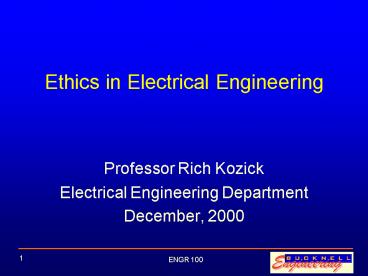Ethics in Electrical Engineering - PowerPoint PPT Presentation
1 / 13
Title:
Ethics in Electrical Engineering
Description:
Ethics in Electrical Engineering. Professor Rich Kozick. Electrical Engineering Department ... IEEE Code of Ethics (1990) ... with the Code of Ethics? ... – PowerPoint PPT presentation
Number of Views:2337
Avg rating:3.0/5.0
Title: Ethics in Electrical Engineering
1
Ethics in Electrical Engineering
- Professor Rich Kozick
- Electrical Engineering Department
- December, 2000
2
IEEE Code of Ethics (1990)
- We, the members of the IEEE, in recognition of
the importance of our technologies in affecting
the quality of life throughout the world, and in
accepting a personal obligation to our
profession, its members and the communities we
serve, do hereby commit ourselves to the highest
ethical and professional conduct and agree
3
IEEE Code of Ethics
- 1. to accept responsibility in making
engineering decisions consistent with the safety,
health and welfare of the public, and to disclose
promptly factors that might endanger the public
or the environment
4
IEEE Code of Ethics
- 2. to avoid real or perceived conflicts of
interest whenever possible, and to disclose them
to affected parties when they do exist - 3. to be honest and realistic in stating claims
or estimates based on available data - 4. to reject bribery in all its forms
5
IEEE Code of Ethics
- 5. to improve the understanding of technology,
its appropriate application, and potential
consequences - 6. to maintain and improve our technical
competence and to undertake technological tasks
for others only if qualified by training or
experience, or after full disclosure of pertinent
limitations
6
IEEE Code of Ethics
- 7. to seek, accept, and offer honest criticism
of technical work, to acknowledge and correct
errors, and to credit properly the contributions
of others - 8. to treat fairly all persons regardless of
such factors as race, religion, gender,
disability, age, or national origin
7
IEEE Code of Ethics
- 9. to avoid injuring others, their property,
reputation, or employment by false or malicious
action - 10. to assist colleagues and co-workers in their
professional development and to support them in
following this code of ethics.
8
Steps in Ethical Analysis
- What are the relevant facts?
- What are the moral issues?
- Who are the people affected?
- What are the possible alternatives?
- What are the expected outcomes?
- What are the practical constraints?
- All things considered, what actions can be
morally justified?
9
Flaw in Intel Pentium Chip
- Late 1994 media reports flaw in Pentium
- Inaccuracies in divide for certain inputs
degree depends on inputs and instructions. - Worst case fourth decimal digit 0.000X
- Bit error in 1 out of every 360 billion randomly
fed divides - Discovered by a university researchererrors
easily reproducible - Widely reported by media
10
Intels Response
- They acknowledged the defect, claimed
- insignificant,
- vast majority of users would never notice it.
- Pentium replaced for free only for users with
demonstrated need for unflawed chip. - Users not satisfied negative publicity!
- Intel then replaced for anyone that asked.
11
The Rest of the Story
- Intel was aware of the flaw long before the media
coverage no plan to inform users. - Flaws are common in complex ICs!
- This flaw was already corrected in next version
(but not yet in production) - Intel continued to sell the flawed Pentiums, even
after the media coverageplanned to sell until
supplies exhausted.
12
Questions
- Is there an ethical issue? Or, merely public
relations issues? - Should all defects be revealed to users?
- Would a warning solve the dilemmaThis product
may contain unexpected flaws and might not
operate correctly under all conditions. - What to do when it is impossible to remove all
defects in a product? (EE CS!)
13
Canons from IEEE Code of Ethics
- 1. ... making engineering decisions consistent
with the safety, health and welfare of the public
- 3. to be honest and realistic in stating claims
or estimates based on available data - 7. to seek, accept, and offer honest criticism
of technical work, to acknowledge and correct
errors,
14
Questions
- Was Intels approach consistent with the Code of
Ethics? - Initially, no plan to notify users of the known
flaw with division - Replace Pentium upon request from users
- Continue to sell Pentiums that were known to be
flawed































